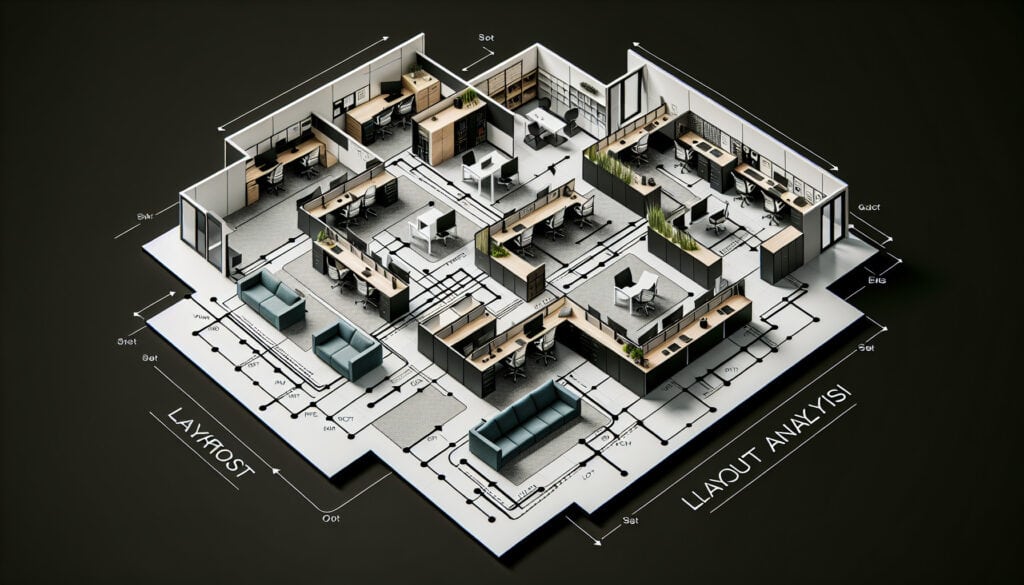Analyser et optimiser l'aménagement d'un espace physique.
- Méthodologies : Clients et marketing, Économie, Conception de Produits
Analyse de la mise en page

Analyse de la mise en page
- Amélioration continue, Conception pour la fabrication (DfM), Efficacité, Ergonomie, Production allégée, Optimisation des processus, Productivité, Simulation
Objectif :
Comment il est utilisé :
- Le processus d'analyse de l'agencement d'un espace physique, tel qu'une usine ou un bureau, afin d'améliorer l'efficacité, la sécurité et la productivité. Il implique souvent l'utilisation d'outils tels que les diagrammes de flux et la simulation pour modéliser le mouvement des personnes et des matériaux.
Avantages
- Peut améliorer l'efficacité et réduire les coûts ; Peut améliorer la sécurité et l'ergonomie.
Inconvénients
- Peut prendre du temps et être complexe à réaliser ; peut nécessiter des logiciels spécialisés et de l'expertise.
Catégories :
- Ergonomie, Fabrication
Idéal pour :
- Optimiser l'agencement d'une usine ou d'un bureau pour améliorer l'efficacité et la sécurité.
L'analyse de l'agencement constitue une approche stratégique dans divers secteurs, notamment la fabrication, l'entreposage, les soins de santé et les environnements de bureau, où l'optimisation de l'agencement spatial peut conduire à l'amélioration des flux de travail et à une meilleure utilisation des ressources. Dans le contexte d'une usine, cette méthodologie est généralement employée au cours de la phase de conception ou de réévaluation, lorsque les ingénieurs et les responsables des opérations collaborent pour évaluer les aménagements actuels à l'aide d'outils tels que les diagrammes de flux de processus. En modélisant le mouvement des matériaux et du personnel, les goulets d'étranglement peuvent être identifiés et traités, ce qui permet de réduire les temps de cycle et de minimiser les déchets. Dans les bureaux, l'analyse de l'agencement peut être menée pour améliorer la collaboration et la productivité en aménageant les postes de travail et les zones de réunion de manière à favoriser une communication efficace au sein des équipes. Les participants peuvent être des planificateurs, des experts en ergonomie et des responsables de la sécurité qui travaillent ensemble pour s'assurer que l'espace répond à la fois aux besoins opérationnels et aux réglementations en matière de sécurité sur le lieu de travail. Les hôpitaux utilisent souvent l'analyse de l'agencement pour optimiser le flux des patients, réduire les temps d'attente et améliorer l'expérience globale des soins, ce qui peut conduire à de meilleurs résultats en matière de santé. L'utilisation d'outils de simulation permet aux parties prenantes d'expérimenter virtuellement différentes configurations, ce qui conduit à des décisions fondées sur des données qui peuvent réduire de manière significative les coûts associés aux temps d'arrêt et aux incidents de sécurité, tout en améliorant le moral des employés grâce à des conceptions ergonomiques. La mise en œuvre d'une analyse efficace de l'aménagement favorise un environnement propice à l'amélioration continue, contribuant ainsi au succès opérationnel à long terme.
Principales étapes de cette méthodologie
- Identifier les flux de travail et les processus critiques au sein de l'espace.
- Cartographier l'agencement actuel à l'aide de diagrammes de flux pour visualiser les schémas de déplacement.
- Analyser les voies de circulation pour en vérifier l'efficacité, la sécurité et l'ergonomie.
- Identifier les goulets d'étranglement ou les obstacles qui affectent le flux de travail.
- Évaluer l'utilisation de l'espace et l'efficacité du stockage.
- Utiliser des outils de simulation pour modéliser les changements de présentation proposés.
- Tester les alternatives de mise en page au moyen de simulations afin d'en évaluer l'impact.
- Affiner les options de mise en page sur la base des résultats de la simulation et du retour d'information.
- Mettre en œuvre la disposition choisie en y apportant les modifications nécessaires.
- Contrôler les indicateurs de performance et ajuster la mise en page si nécessaire.
Conseils de pro
- Intégrer Principes de l'allégement en cartographiant les flux de valeur afin d'éliminer le gaspillage et d'améliorer l'efficacité du flux de travail dans la conception de l'agencement.
- Utiliser des outils de simulation continue pour évaluer les interactions dynamiques entre les travailleurs et les matériaux, afin d'optimiser les voies de circulation.
- Intégrer des évaluations ergonomiques dans les décisions d'aménagement, afin de garantir que les postes de travail favorisent la santé et la sécurité des utilisateurs tout en maximisant la productivité.
Lire et comparer plusieurs méthodologies, nous recommandons le
> Référentiel méthodologique étendu <
ainsi que plus de 400 autres méthodologies.
Vos commentaires sur cette méthodologie ou des informations supplémentaires sont les bienvenus sur le site web de la Commission européenne. section des commentaires ci-dessous ↓ , ainsi que toute idée ou lien en rapport avec l'ingénierie.
Contexte historique
1949
1950
1950
1960
1960
1960
1960
1940
1950
1950
1958
1960
1960
1960
1960
(si la date est inconnue ou n'est pas pertinente, par exemple "mécanique des fluides", une estimation arrondie de son émergence notable est fournie)















Articles Similaires
Programme directeur de production (PDP)
Personnalisation de masse
Entonnoir marketing
Audit marketing
Indice MAPO (Mouvement et assistance des patients hospitalisés)
Planification des ressources de fabrication (MRP II)